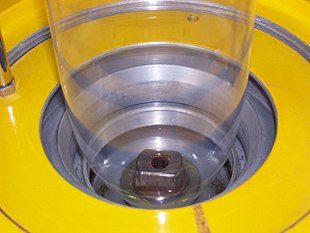Plastics processing
As plastics processing , production is of plastic products referred to. This happens in particular through the production of molded parts , semi-finished products , fibers or foils made of plastics , which are usually supplied by the chemical industry as granules ( masterbatch ), powder, foils or plates .
The manufacturing processes in Germany are classified according to DIN 8580. Primary forming , forming and joining processes are particularly important for plastics processing .
Primary molding process
The production of solid geometric bodies, such as molded parts (pipes, housing parts for televisions, cups and countless others) from shapeless materials, such as melts or powder, is called archetype. These processes are the most important form of shaping for thermoplastics (previously called injection molding compounds ). Post-processing can be omitted in most cases. For thermosets (formerly known as molding compounds ), only primary forming processes can be used, not forming processes.
Injection molding
In injection molding, the plastic is injected from a plasticizing device (heats the plastic to melting temperature) into a cavity ( mold ), in which it is first compressed and then cooled. The molded part is then automatically ejected. The advantage of this process is that even more complex molded parts can be produced in large numbers very quickly and fully automatically. A disadvantage is the high unit costs for the molding tools.
Extrusion
During extrusion, the plastic passes through a funnel into a cylinder, is melted, homogenized and compressed, and then pressed through a nozzle by means of a screw. This system is called an extruder . Extruders are used for the production of profiles, pipes, plates, textile fibers ( melt spinning ), masterbatches (color concentrates).
Calendering
During calendering, the plastic is shaped using a series of rollers. It is mainly used for the production of foils, thin panels, floor coverings.
Rotational molding
Rotational molding, also known as rotational molding or rotational sintering, is a special production process used to manufacture large, hollow, seamless plastic parts. During production, molten plastic granulate is deposited on the inner surfaces of the rotating mold as it cools. Due to the nature of the rotary tool, different wall thicknesses can also be realized within a single mold. Areas of application include large housings and transport containers, but dashboards, furniture and toys are also manufactured using rotational molding. Chocolate hollow figures are also produced in a comparable way.
Foam
The processes for producing foams can be divided into three categories:
- Chemical blowing process: The gases that foam the material are released during the polymerization. (e.g. PU foams)
- Physical blowing process: Low-boiling liquids are added to the reaction mixture, which evaporate in the course of the polymerization and thus form the typical gas bubbles. (z. B. foam polystyrene )
- Mechanical blowing process: A gas is blown into a melt of the plastic while stirring.
Injection blow molding
During blow molding, a thermoplastic preform is inflated in a mold. Due to the compressed air, it lies against the inside of the mold and holds it when it cools. This process is mainly used for the production of bottles, barrels, car tanks, etc.
Forming process
Thermoplastics soften when heated. They can then be brought into a new shape with low forming forces. After cooling down, they keep this. An example of the industrial use of this effect is thermoforming .
Joining process
In manufacturing technology, joining is a process that permanently connects two components. For plastics, welding and gluing are mainly used. But also screws , rivets and clinching can be done with plastics.
Welding of plastics
Welding requires meltable materials, so only thermoplastics can be used for this process. The heat for melting the material can be supplied by means of electrical induction heating ( heating element welding ), hot compressed air (hot gas welding ), friction between the molecules ( high frequency welding), light or laser radiation ( radiation welding ) or friction ( friction welding ).
Gluing of plastics
In contrast to welding, gluing is also suitable for thermosets and elastomers. The basic requirement is that the plastics to be bonded have polar properties. A distinction is made between physical adhesives , in which the molecular structure of the adhesive is already present before application and it hardens by evaporation of a solvent, and chemical adhesives , in which a chemical reaction causes the hardening.
Plastic processing industry
The General Association of the Plastics Processing Industry (GKV) is the association of plastics processing producers in Germany.
| Economic sector | Shares (in terms of value) |
|---|---|
| packagings | 32.4% |
| Construction | 25.2% |
| vehicle construction | 9.2% |
| Electrical goods | 7.4% |
| Housewares | 2.9% |
| Furniture industry | 3.8% |
| Agriculture | 2.5% |
| medicine | 1.7% |
| sport and freetime | 14.9% |
Individual evidence
- ^ A. Franck: Kunststoffkompendium. 4th edition. Vogel Buchverlag, Würzburg 1996, ISBN 3-8023-1589-8 .
- ^ W. Kaiser: Synthetic chemistry for engineers. Carl Hanser Verlag, Munich 2006, ISBN 3-446-22069-0 .
- ↑ vdi news. 42/10 according to Consultic study 2008.



